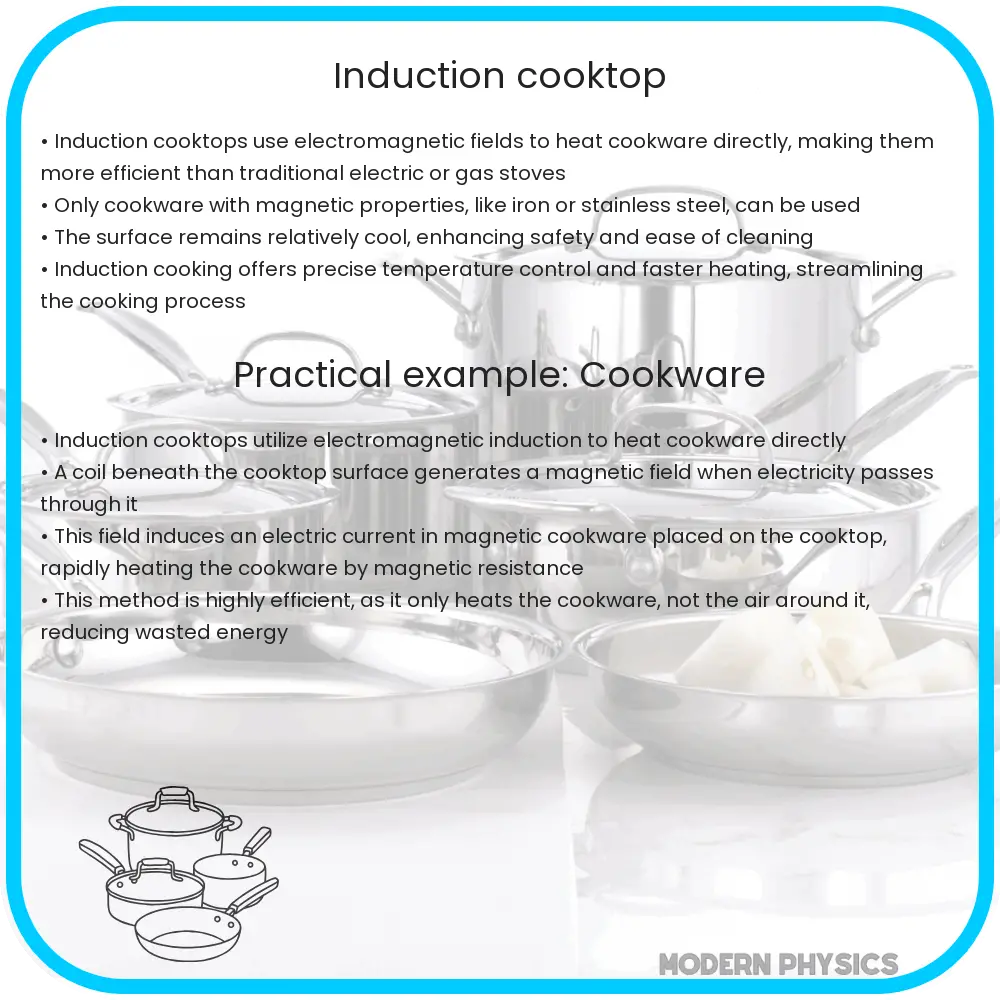Learn how induction cooktops use electromagnetic fields to heat cookware efficiently and safely for precision in cooking.

Induction Cooktops: Harnessing Electromagnetic Fields for Efficient Cooking
Induction cooktops represent a fascinating application of electromagnetic theory, offering a combination of culinary precision, efficiency, and safety. Unlike traditional gas or electric stoves that rely on direct flame or heating elements, induction cooktops use electromagnetic fields to generate heat directly within the cookware itself.
Understanding Electromagnetic Induction
The principle behind an induction cooktop is based on electromagnetic induction, a phenomenon discovered by Michael Faraday in the 1830s. According to Faraday’s law of electromagnetic induction, a changing magnetic field within a circuit induces a current in an adjacent circuit. In the context of induction cooktops, a coil of copper wire is placed under the cooking surface and when electric current passes through this coil, it creates a dynamic magnetic field.
The cookware that needs to be used on an induction cooktop must be made of a magnetic-based material, typically iron or stainless steel. When such cookware is placed on the cooktop, the magnetic field produced by the coil penetrates the cookware and induces swirling electric currents known as eddy currents. These currents generate resistive heating which in turn cooks the food. This process can be described by the equation:
P = I2R
where P is the power dissipated as heat, I is the induced current, and R is the resistance of the cookware. This method of heating directly uses the resistive properties of the pan to generate heat, rather than heating the stove and transferring the heat to the pan.
Efficiency and Energy Transfer
One of the standout features of induction cooktops is their efficiency. The direct generation of heat in the cookware minimizes losses associated with heating elements and the air around the pot, which are often inevitable with other cooking methods. The efficiency of an induction cooktop can be significantly higher than gas or traditional electric cooking surfaces.
Additionally, the ability to directly control the electromagnetic field allows induction cooktops to offer precise temperature control. This capability enables immediate adjustments in heat levels, which is particularly advantageous for preparations that require meticulous temperature management.
Safety Features
Induction cooktops are also considered safer than conventional cooktops due to their cool-to-touch surfaces. The cooking process itself is inherently safer as the heat is generated inside the cookware rather than on the cooking surface. This means that the cooktop stays relatively cool, diminishing the risk of burns from touching the stovetop. Additionally, induction cooktops often come equipped with safety features such as automatic shut-off and pan detection technology, which further enhances their safety profile.
With their efficient operation, precise control, and robust safety features, induction cooktops are a testament to the practical application of electromagnetic theory in everyday life. In the next section, we’ll discuss the implications of these features in more detail and explore how they contribute to the cooking experience and environmental sustainability.
Environmental Impact and Sustainability
Induction cooktops not only excel in efficiency and safety but also pose a lesser environmental burden compared to their gas or traditional electric counterparts. Since induction cooktops use electricity, they can potentially be powered by renewable resources like solar or wind, offering a greener cooking solution. The reduction in energy consumption inherently leads to a decrease in greenhouse gas emissions, particularly if the electricity is sourced from renewable energy.
Moreover, the precise temperature control and quicker cooking times reduce energy wastage. This aspect is crucial in minimizing the overall ecological footprint of everyday cooking practices. It’s a step towards sustainable living, making induction cooktops an appealing choice for environmentally conscious consumers.
Considerations and Limitations
While the advantages of induction cooktops are compelling, there are considerations to bear in mind. First, they require cookware made of or containing a ferromagnetic material, which can limit the usability of existing kitchenware. Furthermore, there can be an initial cost barrier as induction cooktops generally come with a higher price tag compared to traditional stovetops.
Additionally, some users may find the technology somewhat unfamiliar and may require a learning curve to adjust to the unique features of induction cooking, such as the speed and responsive nature of temperature control.
Conclusion
Induction cooktops embody a remarkable blend of technology and utility, making them an exciting option for modern kitchens. By utilizing the principles of electromagnetic induction, they offer a unique cooking experience that prioritizes efficiency, safety, and control. Although they might come with a higher upfront cost and require specific types of cookware, the benefits they offer align well with the needs of contemporary cooking, while also promoting environmental sustainability.
In conclusion, whether you’re a veteran chef or a home cooking enthusiast, the induction cooktop presents an opportunity to embrace advanced technology for a more efficient and safe culinary experience. It’s not just about cooking; it’s about doing so responsibly, with an eye towards the future of our planet.
